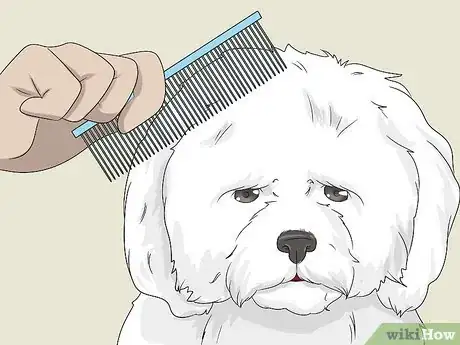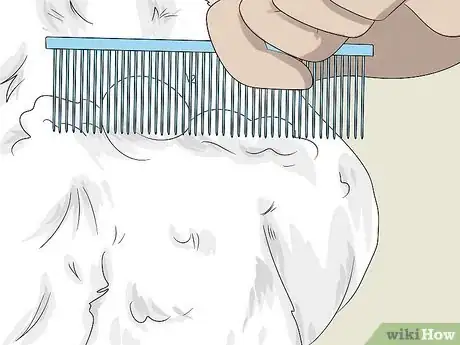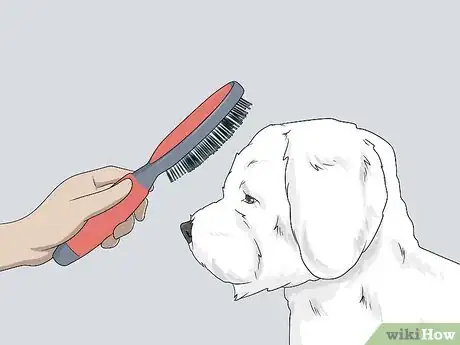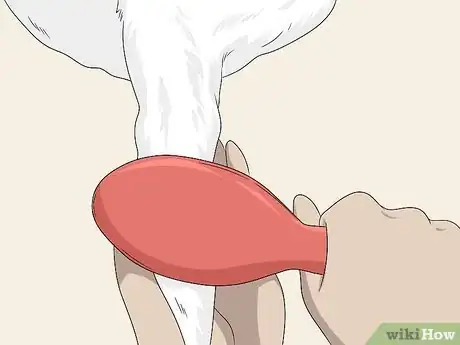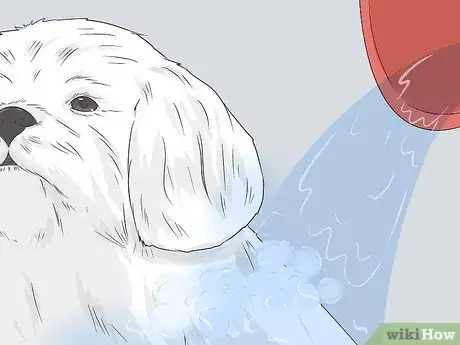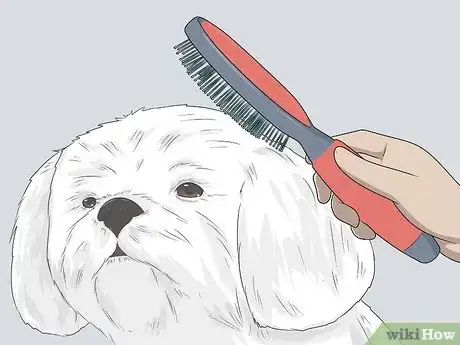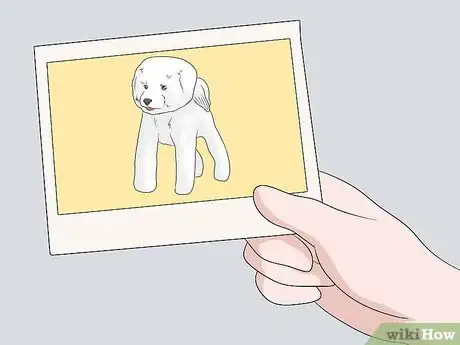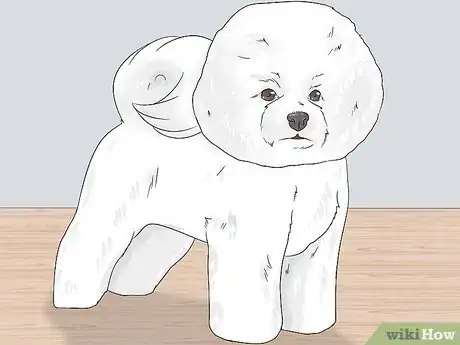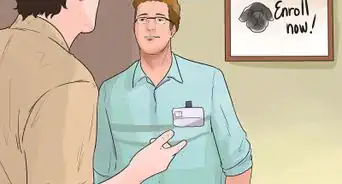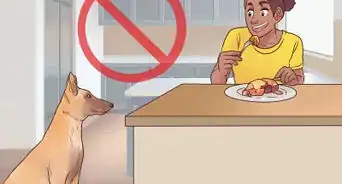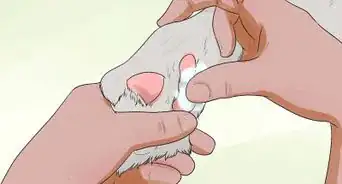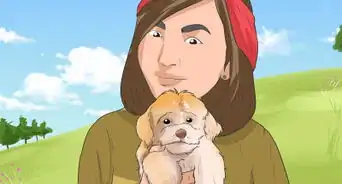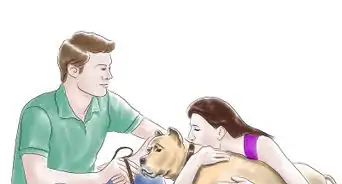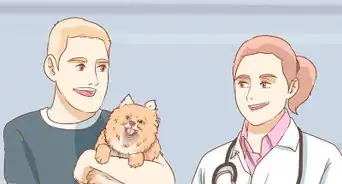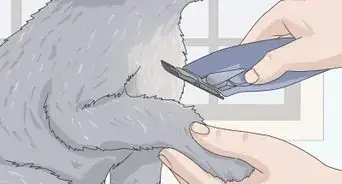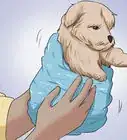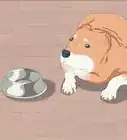This article was co-authored by Pippa Elliott, MRCVS and by wikiHow staff writer, Megaera Lorenz, PhD. Dr. Elliott, BVMS, MRCVS is a veterinarian with over 30 years of experience in veterinary surgery and companion animal practice. She graduated from the University of Glasgow in 1987 with a degree in veterinary medicine and surgery. She has worked at the same animal clinic in her hometown for over 20 years.
There are 8 references cited in this article, which can be found at the bottom of the page.
This article has been viewed 28,323 times.
The Bichon Frise is a small, white dog with a plush, fluffy coat. If you’re thinking about welcoming one of these cute little pups into your home, you’re probably wondering what it takes to maintain their famous puffball look. Although Bichons don’t shed a lot, their coats easily become matted and require a lot of maintenance to keep clean and well-groomed. To keep your Bichon healthy and looking its best, brush and comb it every day and regularly bathe your Bichon and care for its teeth, nails, eyes, and ears. The classic Bichon haircut is hard to achieve, so take your Bichon to a professional groomer once a month for a trim.
Steps
Brushing Your Bichon
-
1Brush and comb your Bichon daily with a pin brush and greyhound comb. Bichons have a double coat that mats easily as the undercoat sheds and gets tangled up in the outer guard hairs. To keep your Bichon’s coat healthy and tangle-free, give it a thorough combing and brushing daily with a greyhound comb and pin brush.[1]
- Even though Bichon puppies don’t tangle much, it’s important to start brushing them early so they get used to the process. Brush your puppy every day with a pin brush, then comb the ends of its fur with a medium-tooth comb (like a greyhound comb).
- A greyhound comb has metal teeth and is designed to comb through medium or coarse hair. You can buy one from a pet supply store or order it online. Pin brushes are available in any pet supply store.
- Have your dog lie down on its side while you brush it. This will make the process easier for you and more comfortable for your dog.[2]
Tip: Always use a pin brush for daily brushing and before and after bath times. You can use a slicker brush to finish off your Bichon’s style when you’re blow-drying its freshly-detangled fur after a bath.
-
2Work through any knots or mats carefully with a greyhound comb. As you’re brushing your Bichon, you’re likely to encounter tangles and small mats. It’s important to get these out before they get out of hand. Use the end tooth of a medium-coarse comb, like a greyhound comb, to work out any tangles you encounter. Start with the end of the tangle farthest from the skin, then work your way down closer to the skin as you tease out the knots.[3]
- If you’re having trouble working through the tangles, try a dog-friendly detangling spray. Be very careful not to get any of the spray in your Bichon’s eyes. You can buy a detangling spray for your dog online, from your groomer, or from a pet supply store.
Advertisement -
3Brush the dog’s head hair toward its face with a pin brush. Start by brushing the fur on your dog’s head. To keep the fur looking nice and fluffy and lift out the loose undercoat hairs, brush the hair up from the base and towards the face rather than brushing it down flat against the skin.[4]
- Take care not to poke the dog’s eyes with the brush pins.
-
4Move on to the dog’s sides and back, brushing up toward the spine. Use the pin brush to brush out the fur along the sides of your dog’s body. Keep brushing up from the skin to the ends of the fur, and work your way up towards the spine.[5]
- On very young Bichons that are just starting to get their double coat, give special attention to the area around the lower back, where the guard hairs first start to grow in.
-
5Go over the legs with the pin brush, brushing the hair up and out. Use your comb to detangle any mats, then brush out the fur on the legs. Just like with the rest of the Bichon’s body, brush up from the roots of the hair to the ends to keep it fluffy and pull out any dead undercoat.[6]
- Tangles are usually most common on a Bichon’s legs, especially if your dog likes to chew or lick itself a lot. Get rid of any knots first so that you don’t pull your dog’s hair while you’re brushing its legs.
-
6Start brushing the undersides of the ears and then move to the outsides. The fur on the Bichon’s ears tends to be long and flowing. Beginning with the undersides of the ears, brush or comb the ends of the fur first to get rid of any tangles. Use a pin brush or greyhound comb. Then, move up about 1 inch (2.5 cm) closer to the skin and brush from there to the ends. Keep doing this until you’re able to easily pull the brush through the whole length of the hair.[7]
- Once you’re done with the undersides of the ears, go over the outer surface with the pin brush.
- Take the opportunity to examine your Bichon’s ears for any signs of inflammation, discharge, or redness. If you notice any problems, call your vet.
-
7Detangle the tail hair starting from the ends and work toward the base. Like the ears, the Bichon’s tail has long fur that can become tangled easily. Don’t brush up from the base like you would on the dog’s face and body. Instead, take your pin brush and start brushing from the ends of the hair and slowly work your way closer to the skin until you can easily move the brush all the way through the fur from roots to tips.[8]
- If you encounter any particularly tough tangles, use a greyhound comb and some detangling spray to help you work through them.
-
8Take your dog to the vet if you notice any sores or bumps during brushing. As you’re combing and brushing your Bichon, look out for any signs of problems, such as sores, rashes, or bumps in the skin. If you notice any issues, make an appointment with your vet to get a proper diagnosis and treatment.[9]
- Keep an eye out for fleas, which will look like small black or dark brown insects wiggling or crawling through your dog’s fur. You might also notice flea dirt, which looks like tiny black or reddish specks.
- Bichons are very prone to allergies, which can cause their skin to become itchy, red, or rashy. These allergies can also affect the ears and lead to infections, so check for signs of irritation or discharge in your Bichon’s ears. You may also notice your bichon is chewing or licking its paws, which may take on a brown or reddish appearance.[10]
Caring for Your Bichon’s Hygiene
-
1Clean the hair under your Bichon’s eyes with a damp cloth several times a day. Like many white dogs, Bichons are prone to tear staining. You can prevent this by keeping the fur under your dog’s eyes clean. If you notice tearing around your dog’s eyes throughout the day, dampen a washcloth with water. Wipe the washcloth on the area under and around your dog’s eyes to remove any tears before they can stain the fur, then use a blow-dryer on a cool setting to dry the fur.[11]
- Comb out the fur after you wet it to keep it from tangling.
- You can also wipe the area with a 3% hydrogen peroxide solution on a paper towel, but be very careful not to get this in your dog’s eyes.
- If your Bichon has a lot of problems with tear stains, see your vet to make sure there’s not a serious underlying cause, such as an eye infection, excessive tear production, or blocked tear ducts. Never use eye drops or ointments in your dog’s eyes without your vet’s recommendation.
Tip: You can also reduce tear staining by trimming the fur around your Bichon’s eyes. If you’re not comfortable doing that yourself, ask a professional groomer or your vet to do it.
-
2Brush your Bichon’s teeth daily with a canine toothbrush. Bichons are prone to dental problems, so it’s especially important to keep their teeth clean. Use a dog toothbrush and dog toothpaste to brush your Bichon’s teeth once daily to remove plaque and food particles.[12]
- You can get dog toothbrushes and toothpaste from your vet’s office or from a pet supply store. Don’t use human toothpaste on your dog.
- While you’re brushing your dog’s teeth, look for signs of problems, such as red or swollen gums, brown or yellow crust on the teeth, or loose or broken teeth. Take your dog to the vet for an evaluation and dental cleaning if you notice any issues.
-
3Trim the hair around your Bichon’s toes once a week. Once a week, examine your bichon’s nails and feet. If you notice any hair growing around and between the toe pads, trim it away with a pair of blunt-nosed scissors. This will help prevent debris and knots from collecting in the hair between your bichon’s toes.[13]
- Long fur, dirt, and tangles around your Bichon’s toes can cause foot pain and make it harder for your dog to get good traction while walking.
-
4Clip your Bichon’s nails at least once every other week. To keep your Bichon’s feet healthy, it’s important to keep its nails trimmed. Use nail clippers, scissors, or a nail grinder to clip the tip of each nail straight across. Don’t trim past the curve of the dog’s claws, since you might accidentally cut the quick (the pink area inside the nails that contains nerves and blood vessels).[14]
- If you’re not sure how to trim your Bichon’s nails, have your vet or a professional groomer show you how to do it properly.
- Keep styptic powder or gel on hand in case you accidentally cut the quick. Apply it to the nail to quickly stop any bleeding.[15]
-
5Clean your Bichon’s ears after bath time or if you notice a mild odor. Your Bichon’s ears probably don’t need to be cleaned daily or even weekly, but it’s a good idea to clean them after baths or if you notice that they have a mild odor. Squeeze a little bit of an ear-cleaning solution recommended by your vet into your dog’s ear, then massage the base of the ear for about 30 seconds. Let your Bichon shake the solution out of its ears, then gently wipe around the entrance of the ear canal with a cotton ball or piece of gauze.[16]
- If you notice that your dog’s ears smell foul or yeasty, look red or inflamed, have a lot of brown or reddish discharge, or seem to be causing your dog pain, call your vet. These are signs of an infection, and you need to get a proper diagnosis so you can treat it properly.
- Never use water to clean your dog’s ears and avoid getting water in the ears during bath time. Dampness in the ears creates an ideal environment for bacteria or yeast to grow.
Bathing Your Bichon
-
1Brush and detangle your dog’s fur before bathing it. If you bathe a Bichon with tangled fur, the mats and tangles will become even tighter and harder to work out. Thoroughly brush and comb your dog with a pin brush and greyhound comb before bathing it, paying special attention to any knotted fur.[17]
- Even if you’ve already brushed your dog’s fur that day, go over it again right before bath time to get rid of any new tangles or tangles that you may have missed.
-
2Bathe your Bichon at least once a month. Bichons need to be bathed at least once a month, or more often if they get dirty. Set aside time to bathe your dog regularly every 2-4 weeks, or whenever you feel a bath is needed. Fill a tub or basin with warm water and place your Bichon in it, then gently wet your dog’s fur and lather it up with a dog-friendly shampoo.[18]
- While you can bathe your dog yourself, many Bichon owners feel more comfortable having a professional groomer do it. Your Bichon should have a bath whenever it goes in for a haircut and styling.
-
3Use a shampoo formulated for white dogs. To keep your Bichon’s fur looking its cleanest and brightest, opt for a whitening shampoo.[19] You can find these online or at a pet supply store, or you may be able to buy one from your groomer. Your dog’s veterinarian can also prescribe a special medicated shampoo if your dog has sensitive skin.
- A few shampoos for white dogs include Bio-Groom Super White Pet Shampoo, Perfect Coat White Pearl Shampoo, and Chris Christensen White on White Shampoo for Pets.
- Don’t use human shampoo on your dog. Human shampoos are formulated differently from dog shampoos, and they can damage your Bichon’s skin and hair.[20]
-
4Wet your dog’s fur to the skin before you apply shampoo. When you’re ready to bathe your Bichon, place it in the tub and thoroughly wet its fur with warm (not hot) water. Work the water in all the way to the skin, since this will help the shampoo work its way through the fur better.[21]
- Take care not to get any water in your Bichon’s ears, since this can cause an ear infection. Try putting a bit of cotton in each ear to help keep water from entering the ear canal.[22]
-
5Lather your Bichon’s fur with shampoo, avoiding the eyes and ears. Following the directions on the bottle, work some dog shampoo through your Bichon’s fur all over its body to create a nice lather.[23] Pay special attention to any areas where your dog’s fur tends to get especially dirty, like the legs, feet, and rear.
- Be especially careful while washing your dog’s head and face, since you don’t want to irritate its eyes and ears with shampoo.
- If you like, use a little dog-friendly conditioner after you rinse out the shampoo to keep your Bichon’s fur soft and healthy.
-
6Rinse out all of the shampoo with warm water. Take care to get all of the shampoo out of your dog’s fur to prevent irritation and dryness.[24] You might find it helpful to use a hand-held shower nozzle on a low-pressure setting, if your shower has one.
- If you use conditioner, rinse that out thoroughly as well.
-
7Towel-dry your Bichon to remove excess moisture. After you rinse your Bichon, allow it to shake out its fur. Then, use a clean towel to gently rub its fur and remove as much moisture as possible.[25]
- Be gentle as you dry your dog, so that you don’t irritate its skin.
-
8Comb out any mats or tangles you missed before the bath. Go over your dog’s fur with a pin brush or greyhound comb and get out any remaining mats or tangles. Use a detangling spray or leave-in conditioner to work out stubborn knots.[26]
- If you use a detangling spray, take care not to get it in your Bichon’s eyes.
-
9Blow-dry your Bichon’s fur with a hair dryer on a low-heat setting. Go over your dog’s fur with a blow-dryer on a warm, gentle setting. Hold the dryer at least 1 foot (30 cm) away from your dog and avoid high heat settings so that you don’t burn its skin.[27]
- Look for a hair dryer made for dogs online or in a pet supply store.[28]
-
10Brush the fur with a slicker brush while blow-drying it. Blow-drying and brushing your Bichon’s fur will help get rid of excess curl and give it the classic “puff-ball” look that Bichons are known for. Use a slicker brush (rather than a pin brush) as you’re blow-drying the fur to smooth out your dog’s fur.[29]
- Don’t use a slicker brush to remove tangles, since this will pull out too much of your Bichon’s undercoat.
Getting Your Bichon’s Fur Cut and Styled
-
1Take your Bichon to a professional groomer once a month. Bichons are high-maintenance dogs that are difficult to groom properly at home.[30] To get your Bichon’s hair trimmed properly, take it to a professional groomer monthly for a bath, cut, and style.[31]
- Find a groomer who has experience with Bichons. Ask your vet or another Bichon owner for recommendations or use a directory like the one on the National Dog Groomers Association of America website to search for groomers near you who specialize in Bichons.
-
2Bring your groomer a picture of the style of haircut you want. Unless you’re trying to meet show dog standards, don’t feel restricted to the standard “puff-ball” Bichon look. Find pictures of cuts you like online and bring the one you like best to your groomer. There are a variety of fun Bichon hairstyles to choose from, such as:
- The “panda cut.” For this look, the groomer uses an electric trimmer to shorten the fur on the Bichon’s body. They leave the hair longer on the head, tail, and legs.
- The “utility cut.” This cut is also sometimes called the “pet cut.” For this cut, your groomer will use electric clippers to trim down most of your dog’s fur close to the skin, just leaving some longer fur on the ears.
- The “teddy bear cut.” For the teddy bear cut, the groomer will cut the fur on the Bichon’s body relatively short, while giving the head, legs, and ears a rounded and puffy teddy bear look.
-
3Choose a shorter style if you want a lower-maintenance cut. If your Bichon is a pet rather than a show dog, opt for a shorter “pet cut.” These cuts are easier to keep clean and tangle-free, and they’re good for dogs that like to run around and play.[32]
- The “utility cut” is a short style that’s especially easy to maintain. You can also ask for a sport trim if your dog is very active or participates in canine sports.
- The “panda cut” is a nice compromise between shorter utility cuts and a full-blown show cut.
-
4Opt for a classic “show cut” if you plan to show your dog. The show cut is the classic Bichon cut, with long, puffed-out fur and a spherical head shape. Ask for this cut if your Bichon is a show dog or if you simply like the classic powder-puff look for your dog.[33]
- To see examples of the classic show cut, visit the Bichon Frise Club of America’s Head Studies gallery on the BFCA website.
Things You’ll Need
Brushing Your Bichon
- Pin brush
- Greyhound comb
- Detangling spray
Caring for Your Bichon’s Hygiene
- Water-free dog shampoo or saline solution
- Wash cloth
- Dog toothbrush
- Dog toothpaste
- Blunt-nosed scissors
- Nail trimmers
- Styptic powder or gel
- Vet-approved ear cleaning solution
- Cotton ball or gauze
Bathing Your Bichon
- Pin brush
- Greyhound comb
- Shampoo for white dogs
- Dog conditioner (optional)
- Cotton balls
- Towel
- Blow dryer
- Slicker brush
References
- ↑ https://bichon.org/grooming-tips/
- ↑ https://bichon.org/grooming-tips/
- ↑ https://bichon.org/grooming-tips/
- ↑ https://bichon.org/grooming-tips/
- ↑ https://bichon.org/grooming-tips/
- ↑ https://bichon.org/grooming-tips/
- ↑ https://bichon.org/grooming-tips/
- ↑ https://bichon.org/grooming-tips/
- ↑ https://bichon.org/grooming-tips/
- ↑ http://aubreyamc.com/canine/bichon-frise/
- ↑ https://www.akc.org/expert-advice/health/tear-stains/
- ↑ https://bichon.org/the-importance-of-good-dental-care-in-a-bichon/
- ↑ https://bichon.org/grooming-tips/
- ↑ https://www.akc.org/expert-advice/health/how-to-trim-dogs-nails-safely/
- ↑ https://bichon.org/grooming-tips/
- ↑ https://www.akc.org/expert-advice/health/how-to-clean-dogs-ears/
- ↑ https://bichon.org/grooming-tips/
- ↑ https://bichon.org/grooming-tips/
- ↑ https://bichon.org/grooming-tips/
- ↑ https://www.akc.org/expert-advice/health/the-soap-and-water-of-dog-ownership/
- ↑ https://www.akc.org/expert-advice/health/the-soap-and-water-of-dog-ownership/
- ↑ https://bichon.org/grooming-tips/
- ↑ https://www.akc.org/expert-advice/health/the-soap-and-water-of-dog-ownership/
- ↑ https://www.akc.org/expert-advice/health/the-soap-and-water-of-dog-ownership/
- ↑ https://www.akc.org/expert-advice/health/the-soap-and-water-of-dog-ownership/
- ↑ https://bichon.org/grooming-tips/
- ↑ https://bichon.org/grooming-tips/
- ↑ https://www.akc.org/expert-advice/health/the-soap-and-water-of-dog-ownership/
- ↑ https://bichon.org/grooming-tips/
- ↑ https://www.akc.org/dog-breeds/bichon-frise/
- ↑ https://bichon.org/grooming-tips/
- ↑ https://bichon.org/grooming-tips/
- ↑ https://bichon.org/grooming-tips/
